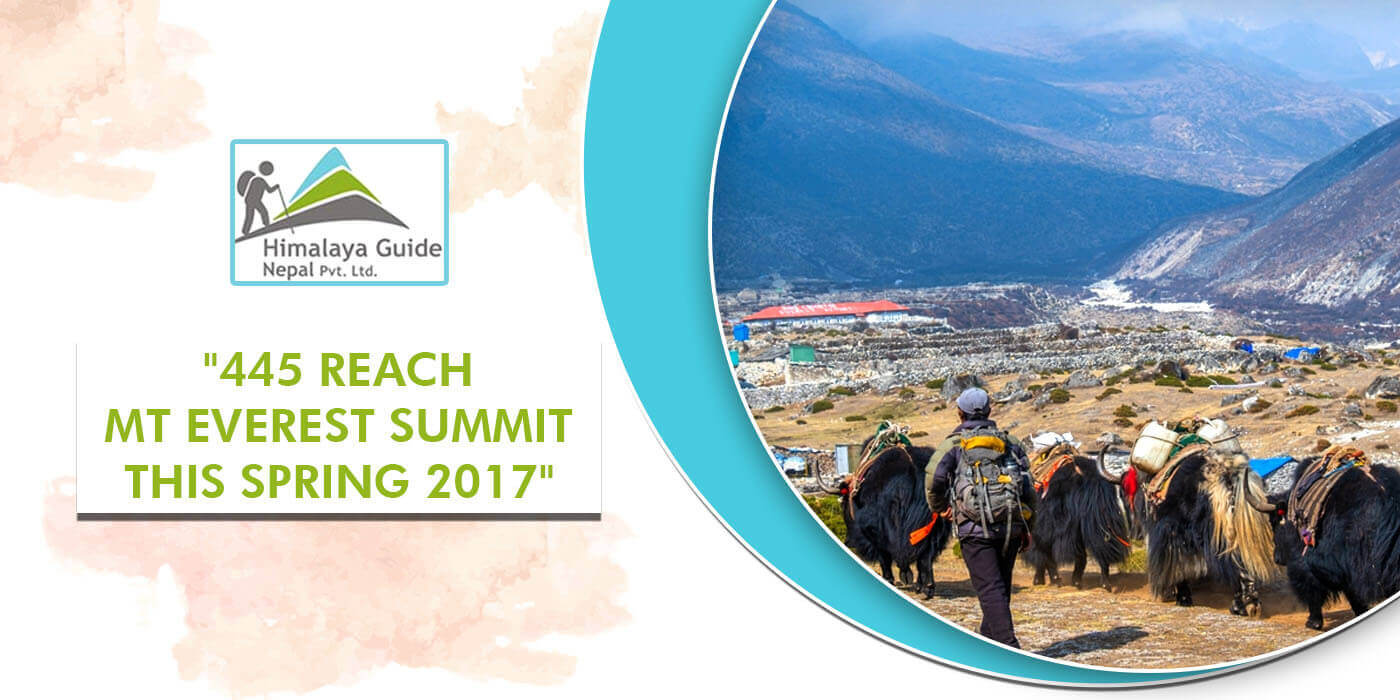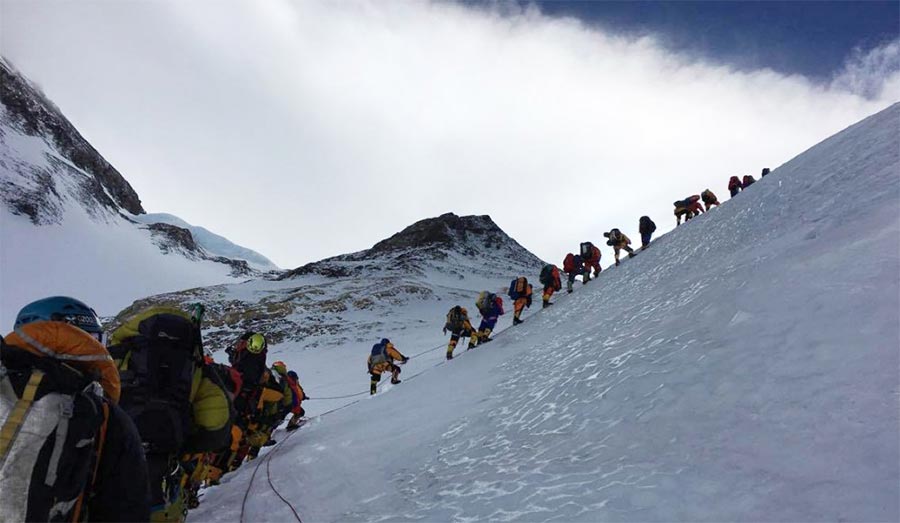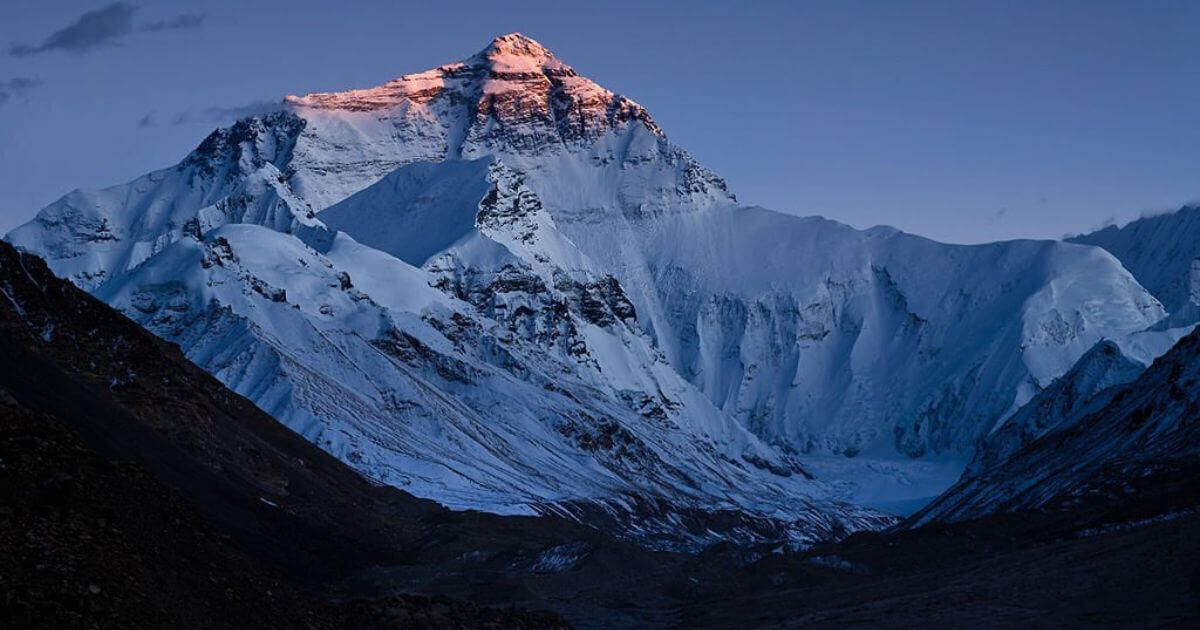445 Reach Mt Everest Summit this Spring 2017

25 May 2018 Chandra Gurung
445 reach Mt. Everest summit this spring: Govt
– SANGAM PRASAIN, Kathmandu
Expedition to Mt. Everest Summit
Many mountaineers have attempted to reach the summit of the world since 1953, when the first individual set foot on it. Some succeeded, but others could not overcome their shortcomings or the problematic weather conditions. Unfortunately, many people could not overcome problems and die as a result.
Ascending Mount Everest and reaching its peak is every severe climber’s goal, and they are willing to put in a lot of time and money to do it. None, however, can accomplish it alone and must rely on the assistance of numerous other individuals. Besides preparing trips for the climbers on Mt Everest, these guides also ensure the climbers’ safety.
The Difficulty of Climbing Mt. Everest
Mount Everest, the most difficult Himalayan peak to reach, is also the greatest desire of many climbers who wish to end their careers with such a climbing experience that demands conquering the hurdles that their bodies construct. They must, however, comprehend the danger and have some prior knowledge.
Climbing Everest is a meticulously planned endeavor. But before heading to the Himalayas, climbers must dedicate a significant amount of time to building stamina and training. To become used to difficult circumstances such as cold temperatures and a low-oxygen atmosphere at higher elevations.
It’s worth recalling that surviving in the “death zone” at 8000 meters above sea level is the most challenging. The body begins to protest the shortage of oxygen. Even the most experienced climbers can suffer impaired judgment, strokes, heart attacks, and difficult-to-overcome altitude sickness.
Nonetheless, some mountaineers climb Mount Everest yearly to prove they can do so. Climbers must first adapt to the decreased oxygen level in the air before attempting to reach the summit. It is possible to accomplish so by making several treks from Everest Base Camp, each time higher.
It allows the body to manufacture more hemoglobin, which transports oxygen from the lungs to the rest of the body and keeps it from dying. Because of this, every trip to Mount Everest must be carefully planned.
Experienced Sherpa guides who have spent their entire adult lives trekking in the Himalayas are the only ones capable of doing it.
All About Mt Everest Summit – Spring 2017

Over 5,000 climbers have set foot on the Mt. Everest summit from Nepal since Edmund Hilary, and Tenzing Norgay Sherpa first conquered the world’s tallest mountain in 1953.
This spring season, which ends on May 31, saw the fourth highest number of successes with 445climbers making it to the hallowed peak, the Tourism Department said. There are now 5,324 Everesters, including these 445.
Giving a breakdown of the summiteers, Khem Raj Aryal, an official at the department that issues climbing permits, has 190 foreigners, 32 fee-paying Nepalis, and 223 high-altitude climbing guides.
The government record is 375 climbing permits this season. An Everest climbing permit costs $11,000 for foreigners and Rs75,000 for Nepalese. Nepal has lost five people this season to the mountain. During preparation for their bids, Swiss mountaineer Ueli Steck and Nepali Min Bahadur Sherchan died.
American doctor Roland Yearwood, Slovak climber Vladimir Strba and an Indian climber Ravi Kumar died above the 8,000 meters mark, an area known as the mountain’s ‘death zone where oxygen levels drop dangerously low, making altitude sickness more likely.
“This year’s success rate is satisfactory given the short window of good weather,” said Aryal. He said it was a safer year on Everest compared to previous seasons. “Many climbers had to return as strong winds prevented them from climbing at the end of the season,” he said.
This year, the climbing season got delayed by a few days. May 15 marked the first attempt by the Gurkha Everest Expedition. The 14 summiteers in the team include soldiers serving with the Brigade of Gurkhas and high-altitude mountain guides.
Everest saw a record number of climbers this season due to a backlog resulting from the 2014 and 2015 avalanches.
During 2014 and 2015, two consecutive avalanches closed the world’s highest peak. Sixteen Nepali guides were killed when a mass of snow slipped down Everest near the base camp on April 18, 2014.
As a result of the cancellation of climbers’ permits in 2014, the government extended their permits until 2019. That year, 326 mountaineers received climbing permits. The first post-avalanche ascent occurred on May 23, 2014, when Chinese climber Wang Jing reached the Mt. Everest summit. However, her ascent sparked controversy as she had flown over the Khumbu Icefall on a helicopter.
Then in 2015, quake-triggered avalanches killed 19 climbers. Not a single climb was done on Everest in 2015. This time, the government extended the permits to climb Mt. Everest summit for two years until 2017. Government statistics show that 451 people climbed Mt. Everest summit last year. Among them, 197 were foreigners.
Published: 10-06-2017 08:56/ source Kathmandupost.com
When Is the Ideal Time to Attempt for Mt. Everest Summit?

Some expert climbers argue that there is always time to accomplish it, although the best time for such an adventure is from April to June when the so-called “climbing window” opens. Peak ascents are ideal at this time of year. Nature awakens at this time of year.
Thus the walk to the Everest Base Camp Trek may be particularly fascinating when considering plant biodiversity. However, in May, which is supposed to be the hottest month in the region, clouds may arise, depriving you of spectacular vistas. In truth, it is tough to anticipate the weather, but May is an excellent choice if you dislike the cold.
How Long Does It Take to Climb Mt. Everest Summit?
The climb to Mt. Everest summit, commonly known as “the roof of the world,” is hardly peaceful. It is not a stroll over lovely snow-covered hills, and it may even be dangerous for those who are untrained or have a low risk of disease. As a result, acclimatization in the Base Camp might take up to 40 days.
During this period, Sherpas provide care to climbers, so they do not become accustomed to the stress and lack of oxygen in the mountains. Only then can the ascent be continued. The 50th day is usually a summit day, the most exciting and challenging journey phase, especially if the weather is excellent.
Regarding tourists, the entire trip takes roughly 58 days from arriving in Kathmandu to summiting the mountain. When everything is in order, and the climbers are in good spirits, the ascent to the summit takes roughly seven days. It takes approximately 5 days to return to the Base Camp.
The Oxygen Formula
As climbers queue up at the summit, oxygen supply becomes a critical safety issue. Some businesses might not offer enough oxygen to keep employees safe when problems occur.
It becomes a financial issue, and many individuals choose to save money. The expense of transporting an oxygen canister to the top can easily exceed $1,000, if not more. Each climber should bring three to four liters for the day before summit time and another four liters for summit time.
Sherpas carrying all that extra oxygen require around half that amount.
Safety Comes at a Cost
To some extent, the more you pay on Everest, the more help you may get. It implies that sherpas will carry more of your equipment, including additional oxygen tanks.
However, you must be fit and healthy enough to climb the mountain. It is difficult to scramble up high rocks and snow when wearing crampons (spikes).
The basic technique of utilizing a fixed rope as a handrail instead of practically hauling oneself up the mountain on a thin (potentially breakable) cable requires talent and experience – abilities rarely addressed in a rush to the peak.
Frequently Asked Question:
- What is the summit of Everest?
The peak of Everest represents the highest point on Earth’s surface above sea level. Several other mountains are occasionally called the “world’s highest mountains on Earth.”
- Who scaled Mount Everest in 2017?
Kami Rita Sherpa peaked for the 21st time on May 27, 2017. The only persons who have done so are Apa Sherpa and Phurba Tashi Sherpa.
- Who ascended Mount Everest without oxygen in 2017?
Adrian Ballinger stood on the peak of Mount Everest – 29,029 feet — for the first time on May 27 with just the air in his lungs. He didn’t need any more oxygen to get there.
- Is it possible to land a helicopter on Mount Everest?
The answer to whether a helicopter can hover to the summit of Mount Everest is yes. It has been attempted previously, but just once. Didier DelSalle flew to and landed on Mount Everest’s 8,848 m (29,030 ft) summit in 2005.
- Why are you unable to climb Everest during the summer?
The climbing period during April and May is among the most incredible seasons for mountaineers to undertake a summit ascent. Summer may appear to be the best time to visit Mount Everest, from mid-June to August, but it’s also monsoon season, during which the summit might experience heavy rain.
